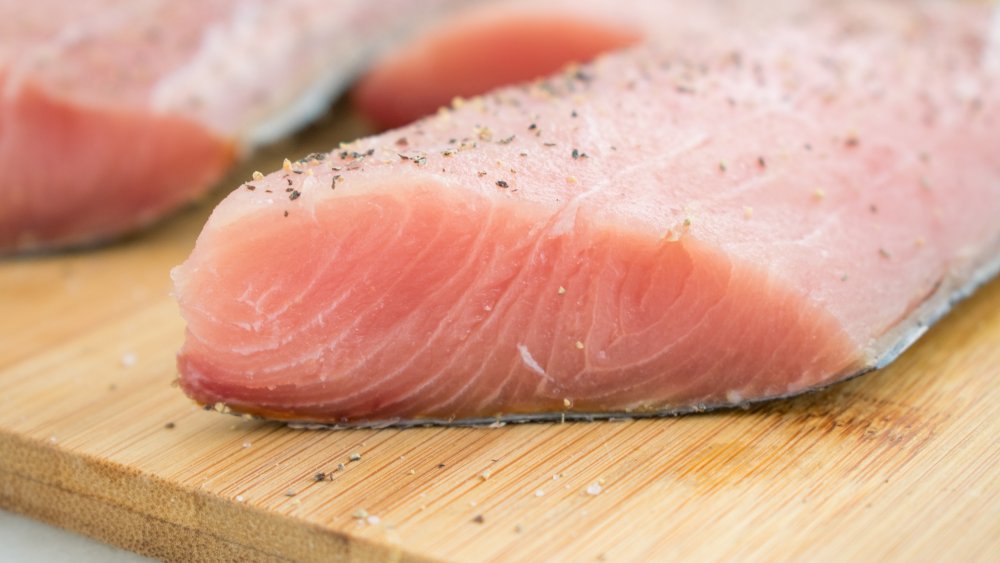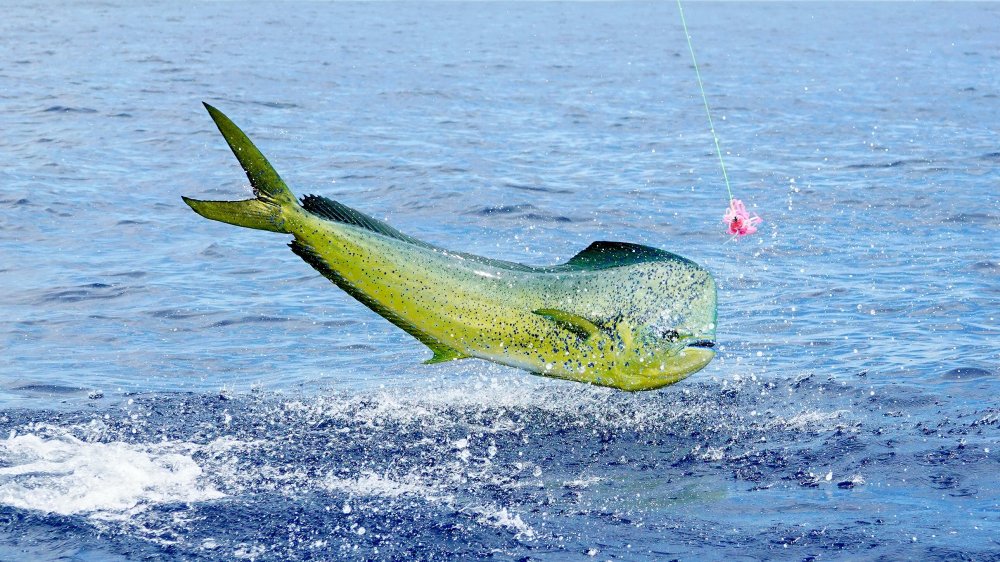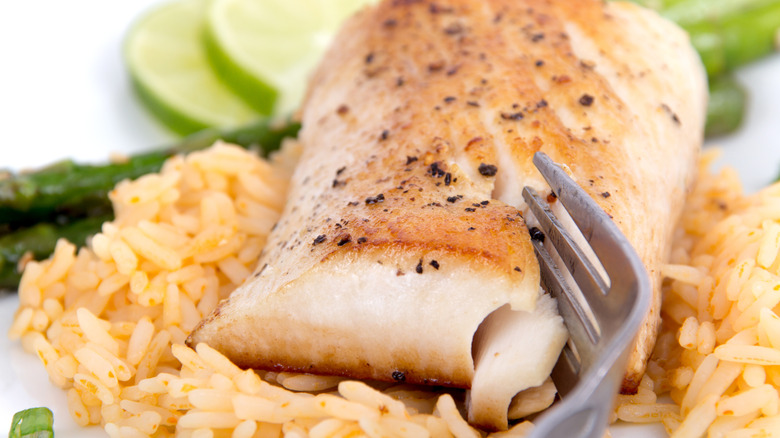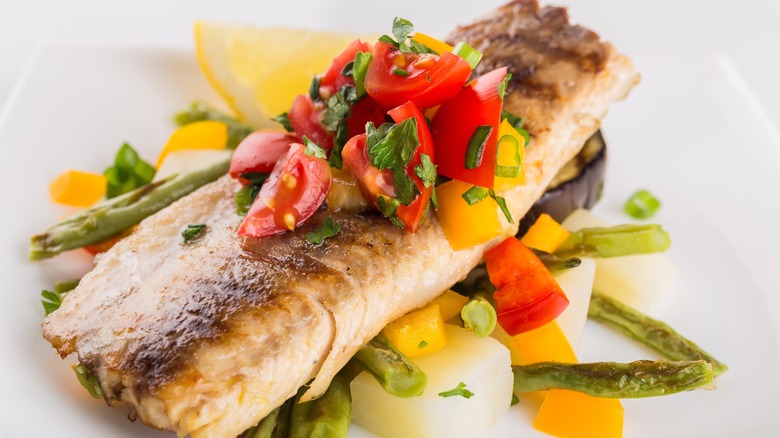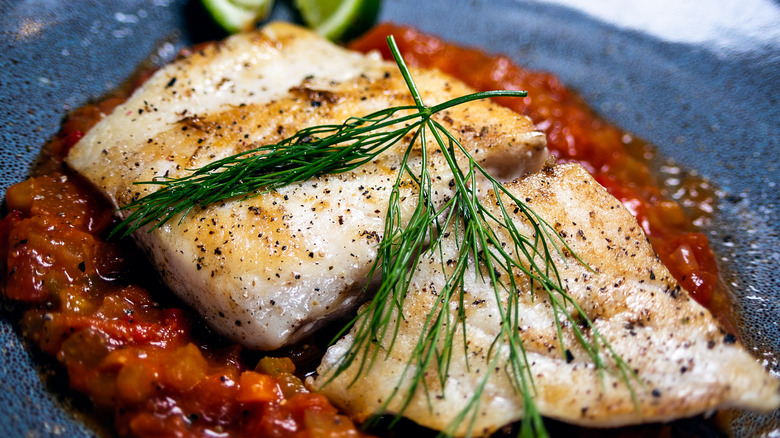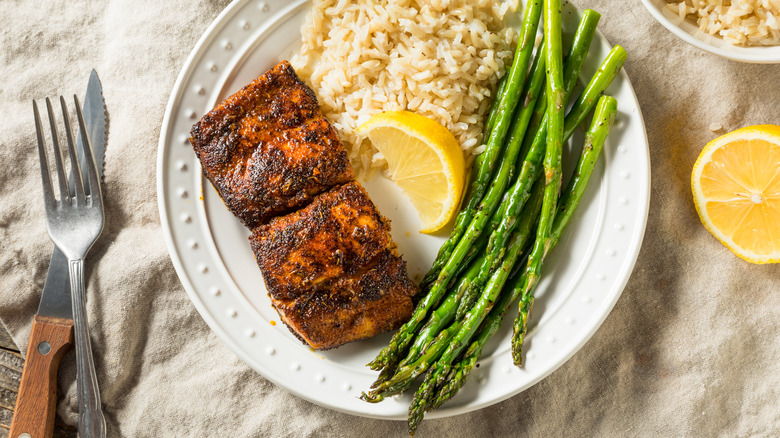What Is Mahi-Mahi And What Does It Taste Like?
Mahi-mahi (Coryphaena hippurus), otherwise known as the common dolphinfish, per Oceana, is a fish that lives in warm-weather climates such as in the waters of the Gulf of Mexico, in the Caribbean, and around Hawaii (via The Kitchn). They are typically under three feet and 30 pounds but can grow up to six feet in length (via Sciencing). Mahi-mahi is an unusual-looking fish and the males sport a distinctively humped head. This fish is extremely popular in the sportfishing world, and with its vivid green and yellow coloring, it's one of the brightest fish one might pull up during a deep-sea fishing expedition. Mahi-mahi is classified as a "best choice" by the seafood watchdog Monterey Bay Aquarium, the highest option in its ranking system.
But more important than its color or where in the world it's found, what is its flavor profile?
What mahi-mahi tastes like
Many foodies will tell you that the fish that tastes the closest to mahi-mahi is halibut, another type of whitefish, albeit one from much colder regions of the ocean such as British Columbia and Alaska (via National Oceanic and Atmospheric Administration). No flavor comparison is ever 100% spot-on though, and some people think that mahi-mahi is stronger or more "fishy" than halibut. And though it does seem surprising that such a colorful fish has such an ordinary taste, it's true.
Mahi-mahi, with its tropical name and vibrant skin, isn't much different from other whitefish once it's filleted. Another frequent comparison is to swordfish, which also has a very lean meat and firm, dense texture like mahi-mahi. Because it's lean and low on fat, mahi-mahi is a healthy choice and the fact that it isn't flaky and fragile makes it a great option to throw on the grill at a barbecue.
How do you cook mahi-mahi?
Similar to many other fish, mahi-mahi is so terrific on its own that it doesn't need much to gussy it up — in most cases, lemon, fresh herbs, and a touch of butter are good enough and help to bolster the natural flavor of the fish and its distinctive texture. As mentioned earlier, grilling is an excellent option, but so is oven-roasting or pan-roasting. Mahi-mahi can also hold up to stronger tastes, such as a Cajun seasoning blend — giving your mild fish quite the kick. It also pairs beautifully with citrus flavors, such as an orange or lime glaze, according to Emeril's Test Kitchen. And of course, it's a terrific option for fish tacos and is also delicious fried (via Food.com). The flavor is mild and the texture should be firm but flaky.
One thing to remember, though, is to be careful with cook-time. Mahi can overcook and dry out very quickly. It shouldn't take more than than 5 minutes per side. According to Thermomeat, all mahi-mahi should be cooked to at least 137 degrees Fahrenheit to be fully cooked and safe to eat.
How to select mahi mahi
Outdoor notes that mahi-mahi is actually one of the fastest-growing fish in the entire ocean, interestingly enough. Furthermore, it also certainly doesn't hurt that it's such a visually striking fish. The colors are so eye-catching!
The Kitchn notes that mahi-mahi — sometimes called dolphinfish — is typically sold as skinless fillets, both fresh and frozen. Related alternatives are halibut (as mentioned earlier), as well as swordfish or snapper. Some tips for purchasing: Be especially be mindful of smell, color, skin, and bones — even though the fish is essentially boneless. Be sure the fish is firm and not fishy-smelling and that its skin is still brightly colored. As FishChoice notes, mahi-mahi isn't limited to any one season. Also, the meat should be firm with a subtle pink hue. The purchasing is really the trickiest part — as mentioned, the actual cookery of mahi-mahi is pretty simple.
Where do you buy mahi-mahi?
Of course, it is important that you're purchasing all mahi-mahi from a reputable vendor. A fishmonger is a great option, or a high-end fish counter at some supermarkets. Many online retailers also sell very high-quality mahi-mahi, in case you're unable to find it at a local market or grocery store. If fresh is unavailable in your immediate area, frozen should almost always be available at many stores. Purchasing a whole fresh fish can be tricky, so many opt for frozen, pre-portioned fillets regardless.
If you do buy your own whole fish, be very careful when fileting at home. Key Largo Fisheries notes that it is paramount to have plenty of room with which to work, a large cutting board, and a sturdy, durable filleting knife (ideally the flexible kind). Filleting essentially is removing the head, tail, and backbone, removing the belly and innards, and then portioning the meat into even-sized fillets.
Nutritional information about mahi-mahi
From a nutritional perspective, mahi-mahi is very low in calories and fat, but high in protein. FishChoice notes that it's packed with selenium, phosphorus, vitamins B12 and B6, potassium, and niacin. It also doesn't have an especially high mercury content, but Food Network does note, however, that children shouldn't consume mahi-mahi more than three times per month due to said mercury levels.
Livestrong states that mahi-mahi is an ideal fish option, because it is low-calorie, lower in mercury than other fish, and contains lots of protein (about 40% of your daily requirements). It also has amino acids and is very low in fat. The cooking method is important, though — a deep-fried piece of fish will obviously not be nearly as healthful as a steamed, broiled, or roasted version. Pucci Foods calls it the "powerhouse" of healthy protein, also nothing that mahi-mahi may contain anti-cancer properties, may prevent health disease, may even help to fight aging. Amazing!
